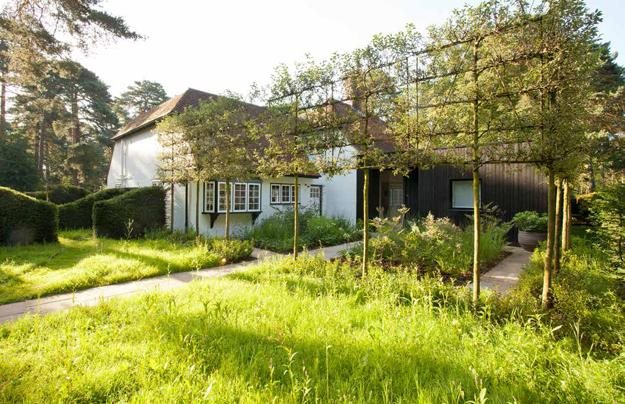Courtyard Garden Blurs the Boundaries
Rows of pleached crabapple trees and a restrained color palette of whites and muted tones provide a natural yet dramatic garden for a Japanese-style cottage in England.This unassuming courtyard garden in the countryside of Buckinghamshire, England, was created to unify an existing home with a new extension while blending in with the natural woodland around it. The extension is clad with carbonized cedar boards inspired by the Japanese cladding technique of shou sugi ban (or charred cedar), creating an unexpected contrast with the more traditional cottage-style home. Yet the marriage works beautifully, with the garden successfully wedding the disparate elements together.

Pleached crabapple trees provide a natural yet dramatic framework for this countryside home while respecting the Japanese design style of the new extension (right). Photo by: Rosangela Photography.
Designed by landscape architect Stefano Marinaz of Stefano Marinaz Landscape Architecture, the garden was inspired by the formality of Japanese design, as reflected in its rows of pleached crabapple trees and restrained color palette. A wildflower meadow and native hedgerows were introduced to blur the boundaries between the domestic garden and the woodland around it.
“If you were to look at the house as it was without the garden, you would notice that the new extension and the house are quite different in style. The garden I created is the element that links the extension to the house. What I love about Japanese design is the simplicity of it. We expressed this by using a color palette of whites and muted tones that complement the color of the extension and the existing house,” says Marinaz.

The wildflower palette of white and muted shades of pink and purple was chosen to complement the charcoal shou-sugi-ban style cladding on the home’s extension. Photo by: Rosangela Photography.
The perfect rows of pleached crabapples provide a natural framework for the landscape design and visually unify the two parts of the house. “The crabapples are quite tall, but at the same time are quite light and let the view and daylight through them, so they let the visitor experience the new space without blocking the view,” Marinaz explains. To maintain this structure and transparency, the trees will require pruning every autumn.
The maturity of the plantings is striking, considering that the project was completed less than a year ago. The crabapple trees are about 12 years old and were brought in from a Belgium nursery, creating the desired effect almost immediately after planting. The hedgerow plants (Taxus baccata) were also mature when installed. The wildflower meadow was sown from seed, yet is already thriving and will be in full bloom next spring. It is located at the front of the property, on either side of the main path, so visitors can enjoy the throngs of bees and butterflies it will attract. “We used seeds for the wildflower meadow in order to increase the variety of plants in it to 30. Usually wildflower turf contains fewer species,” says Marinaz.

The entry to the home is flanked by fields of wildflowers to help blend the grounds with its woodland surroundings. Photo by: Rosangela Photography.
The pleached crabapples possess a commanding presence by day, but are even more dramatic at night, when uplighting emphasizes their stature and uniformity. The trees also provide seasonal interest while harmonizing with the natural environment. “The beauty about the crabapples is the flowers in spring, the light foliage in summer, and the amazing small red apples in autumn and winter. Because of the natural setting of the property, the crabapples merge perfectly with the planting palette in the area. It is quite common in the neighborhood to have orchards on the property,” says Marinaz.

Uplighting transforms the garden at night, showcasing the structural perfection of the hedgerows and pleached crabapples. Photo by: Rosangela Photography.
To see photos of the courtyard garden as it was being installed, visit Stefano Marinaz Landscape Architecture.
See more English gardens.
